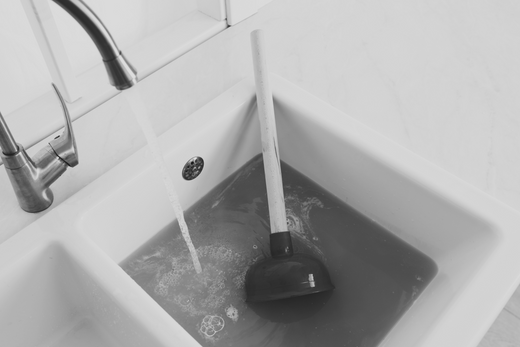
Dealing with Slow Kitchen Drains: What It Means and How to Solve It
A slow kitchen drain can quickly turn a simple chore into a major headache. Whether it’s water pooling around the dishes you’re trying to rinse or that lingering gurgle as the sink finally empties, it’s frustrating—and it’s a sign that something’s not right.
Slow drains don’t just happen overnight; they’re often the result of buildup that’s been quietly forming for weeks or even months.
Understanding what’s causing the issue and taking a few simple steps can get things flowing smoothly again and help you avoid bigger problems down the line.
Signs of a Slow Kitchen Drain
You know what it means to have a clogged kitchen drain but you may not realize that before a drain stops completely, it usually offers warning signs:
- Water takes longer than usual to drain after washing dishes
- Gurgling sounds come from the drain
- Small pools of water remain in the sink
- Unpleasant odors rise from the drain
- Bubbles form while water is draining
Common Causes of Slow Kitchen Drains
Kitchen drains face unique challenges compared to other household drains because of the variety of items that go down the kitchen drain. The main culprits behind slow kitchen drains include:
- Food Particles. Even with a garbage disposal, food particles can build up in pipes over time. Small bits of food stick to pipe walls, gradually narrowing the passage for water flow.
- Grease and Oil. When hot grease or oil cools in pipes, it solidifies and creates stubborn blockages. These sticky substances trap other debris, making the clog worse over time.
- Soap Scum. Dish soap combined with hard water creates a film inside pipes. This residue builds up gradually, reducing water flow and trapping other materials.
- Mineral Buildup. Hard water deposits minerals in pipes, creating scale that narrows the pipe diameter and rough surfaces where debris can collect.
Natural Solutions for Slow Drains
Try these gentle methods first before moving to stronger treatments:
- Hot Water Flush: Boil a full kettle of water and pour it slowly down the drain. The hot water helps dissolve grease and soap scum. Repeat this process several times for better results.
- Salt and Hot Water: Pour half a cup of table salt down the drain, followed with boiling water. Salt acts as a natural scouring agent, helping remove buildup from pipe walls.
- Baking Soda and Vinegar:
-
- Pour 1/2 cup baking soda down the drain
- Add 1/2 cup white vinegar
- Cover the drain immediately with a plug or rag
- Let it fizz for 15 minutes
- Flush with hot water
For more, read our complete guide to preventing drain clogs.
Understanding Enzyme-Based Drain Cleaners
Enzyme cleaners offer a safe and effective solution for slow drains. These biological cleaners work differently from harsh chemical products, as enzymes are natural proteins that break down organic matter. In drains, they target organic material like food waste, grease and oils, soap scum, and paper products. The enzymes consume this organic material, making for a cleaning product that is safe for all kinds of pipes (even old pipes), is non-corrosive, environmentally-conscious, and they're continually working over time which means they are a true preventative that help prevent future clogs.
Using Enzyme Cleaners Effectively
For best results with enzyme-based cleaners:
-
Use them regularly as preventive maintenance
-
Apply before bedtime to allow maximum working time
-
Avoid running hot water for several hours after treatment
-
Use monthly for maintenance even when drains run well
Prevention Tips for Kitchen Drains
Taking these steps helps prevent future drain problems:
Install Drain Strainers
Use quality sink strainers to catch food particles and other debris before they enter the drain.
Proper Grease Disposal
Never pour grease or oil down drains. Instead:
-
Let it cool completely
-
Pour into a container
-
Dispose in regular trash
Regular Maintenance
-
Run hot water for 30 seconds after using the disposal
-
Clean sink strainers daily
-
Flush drains weekly with hot water
-
Use enzyme cleaners monthly
When to Call a Professional
Some situations require professional help:
-
Multiple slow drains throughout the house
-
Repeated clogs despite proper maintenance
-
Unusual sounds from pipes
-
Backups in other drains when water is running
-
Persistent bad odors
Professional plumbers have specialized tools and expertise to:
-
Locate deep clogs
-
Clear main line blockages
-
Identify pipe damage
-
Fix underlying problems
Ensuring Long-Term Drain Health
Maintaining clear drains requires ongoing attention. Create a basic maintenance schedule:
Weekly:
-
Hot water flush
-
Clean sink strainers
-
Check drain flow speed
Monthly:
-
Deep clean garbage disposal
-
Check all kitchen drains
Yearly:
-
Professional inspection
-
Camera inspection if needed
-
Address any developing issues
Final Thoughts
Understanding your kitchen drain system and maintaining it properly saves time and money while preventing frustrating backups. Regular care with the right tools and products keeps water flowing smoothly and your kitchen working efficiently.
Small steps in daily maintenance prevent major problems later. When issues arise, start with gentle solutions and work up to stronger methods as needed. Remember that prevention remains the best strategy for keeping kitchen drains clear and functioning properly.
